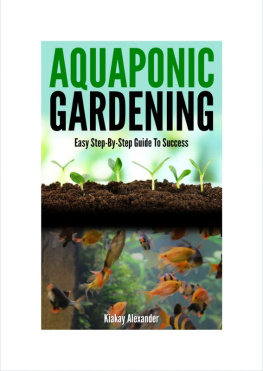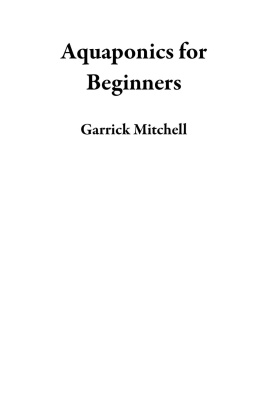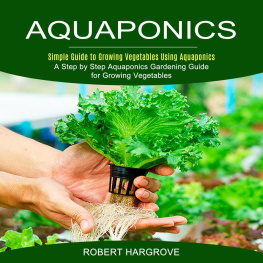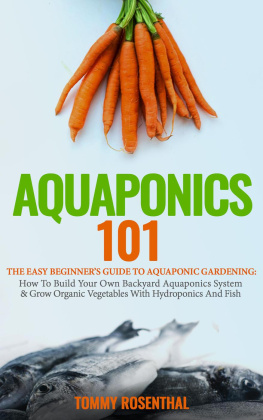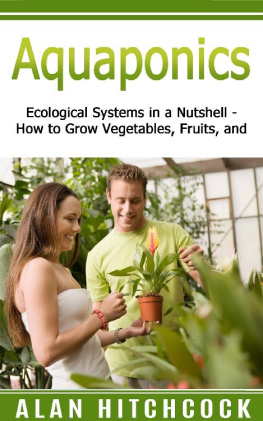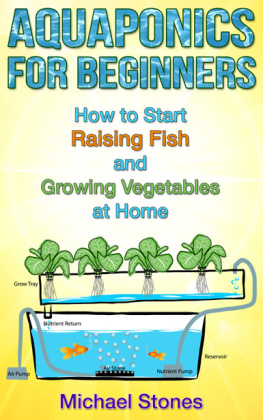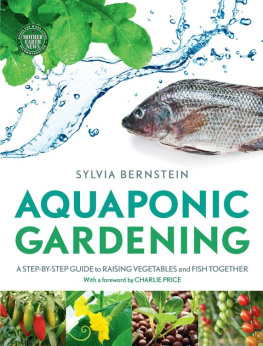To plant a garden is to believe in tomorrow.
Aquaponics captured my interest and fascination the first time I heard about this farming tradition and the theory that underpins it. In my eyes, the most beautiful aspect of aquaponics is that it mirrors nature in its harmonious self-sufficient eco-cycles. This innovative production process is something I wish to share with you. Water is what keeps ecosystems thriving and is essential to our very existence. Water is the foundation of life. Sadly, and worryingly, water scarcity is a profound and imminent problem in todays world. Because of all this, the use of recycled water in aquaponics has never been more attractive.
Motivated by the potential to make food security a priority and frugal living a possibility, I am thrilled to take you on an aquaponic voyage from guiding you through how to build your own fully-sustainable aquaponic garden to breaking down the science into concise, proven steps on how to yield the best results. This easy-to-follow guide is carefully tailored toward hobby gardeners as well as more advanced explorers of urban homesteading.
For your best understanding and results, I recommend reading this book in the order it has been structured with. This essential aquaponics guide will cover the following: An introduction to aquaponics, how it works and its benefits, the best plants and fish to use, aquaponic system designs, how to assemble, cycle and maintain your aquaponic garden, and much more! All information will be presented with clear explanations, reference pictures and diagrams. This DIY guide will give you all the tools you need to create your own aquaponic Eden which will provide you with fresh and organic greens all year round.
By the end of the book, you will be able to create your own customized aquaponic garden by choosing and combining some of the systems and growing options we supply, depending on your food growing goals.
The ultimate goal? To allow you to grow your own food from the comfort of your own home whilst paving your path to a frugal, self-sustaining lifestyle.
Copyright 2016 by Andy Jacobson - All rights reserved.
This document is geared towards providing exact and reliable information in regards to the topic and issue covered. The publication is sold with the idea that the publisher is not required to render accounting, officially permitted, or otherwise, qualified services. If advice is necessary, legal or professional, a practiced individual in the profession should be ordered.
- From a Declaration of Principles which was accepted and approved equally by a Committee of the American Bar Association and a Committee of Publishers and Associations.
In no way is it legal to reproduce, duplicate, or transmit any part of this document in either electronic means or in printed format. Recording of this publication is strictly prohibited and any storage of this document is not allowed unless with written permission from the publisher. All rights reserved.
The information provided herein is stated to be truthful and consistent, in that any liability, in terms of inattention or otherwise, by any usage or abuse of any policies, processes, or directions contained within is the solitary and utter responsibility of the recipient reader. Under no circumstances will any legal responsibility or blame be held against the publisher for any reparation, damages, or monetary loss due to the information herein, either directly or indirectly.
Respective authors own all copyrights not held by the publisher.
The information herein is offered for informational purposes solely, and is universal as so. The presentation of the information is without contract or any type of guarantee assurance.
The trademarks that are used are without any consent, and the publication of the trademark is without permission or backing by the trademark owner. All trademarks and brands within this book are for clarifying purposes only and are the owned by the owners themselves, not affiliated with this document.
Section 1: An Introduction to Aquaponics
The home gardener is part scientist, part artist, part philosopher, part ploughman. He modifies the climate around his home.
- John R. Whiting
What is Aquaponic Gardening?
Aquaponics is a revolutionary, highly effective gardening system which combines conventional aquaculture (raising aquatic animals in tanks) with hydroponics (cultivating plants in soil-free media). In a symbiotic environment, it raises both fish and plants in mutual ecological harmony. Like Hydroponics, the aquaponic growing methods dont require any soil and instead make use of highly oxygenated, nutrient-rich water.
Aquaponic gardening is highly productive in growing organic vegetables, herbs, fruits and raising fish. More so, aquaponic systems are four to six times more productive than ordinary gardens and require 90% less water. On a small scale, they provide a cost-efficient alternative to families and anyone seeking self-sufficiency. On a larger scale, they are a potential solution to urban food insecurity.
Not only is aquaponics among the most effective gardening techniques, but it is the easiest way to grow herbs and vegetables. Aquaponic systems are self-regulating: you dont have to water your plants and you dont have to clean the fish tank. Aside from some simple maintenance tasks (which we will outline in Section 10 ), the only thing left to do is to feed your fish and harvest your vegetables!
The Aquaponic Cycle: How It Works
Put simply, as water is pumped from the fish tank to the grow beds, the fish waste is converted to organic food for your plants. Your plants in turn clean, filter and recycle the water for your fish. Because aquaponics is a closed and recirculating system, it gives rise to naturally occurring bacteria (microbes and worms). These bacteria and worms break down the fish waste (ammonium and nitrites) into fertilizer for your plants (in the form of nitrites).
When absorbing these nutrients, plants naturally filter the water. The clean water then streams back into the aquarium, providing your fish with a clean and oxygenated environment in which they can thrive.

This growing method is environmentally-friendly, natural and economical. Using natural bacterial cycles, it eliminates all need for expensive chemical fertilizers and water filters, all whilst avoiding waster wastage.
We will expand on the many benefits of aquaponics in the next section, before moving on to how you can get started on your journey to self-sufficiency and food independence!
Section 2: The Benefits of Aquaponic Gardening
The destruction of aquatic ecosystem health, and the increasing water scarcity, are in my opinion the most pressing environmental problems facing human kind.
- Maude Barlow
Sustainable Aquaculture:
In aquaponic cycles, the same water is used to raise both fish and plants. Fish waste is used as fertilizer to grow agricultural products. Plants in turn filter and recycle the water, thereby cleaning the fish tank and allowing your fish to thrive. This makes aquaponics one of the most waste-efficient, water-saving and most natural farming systems.


